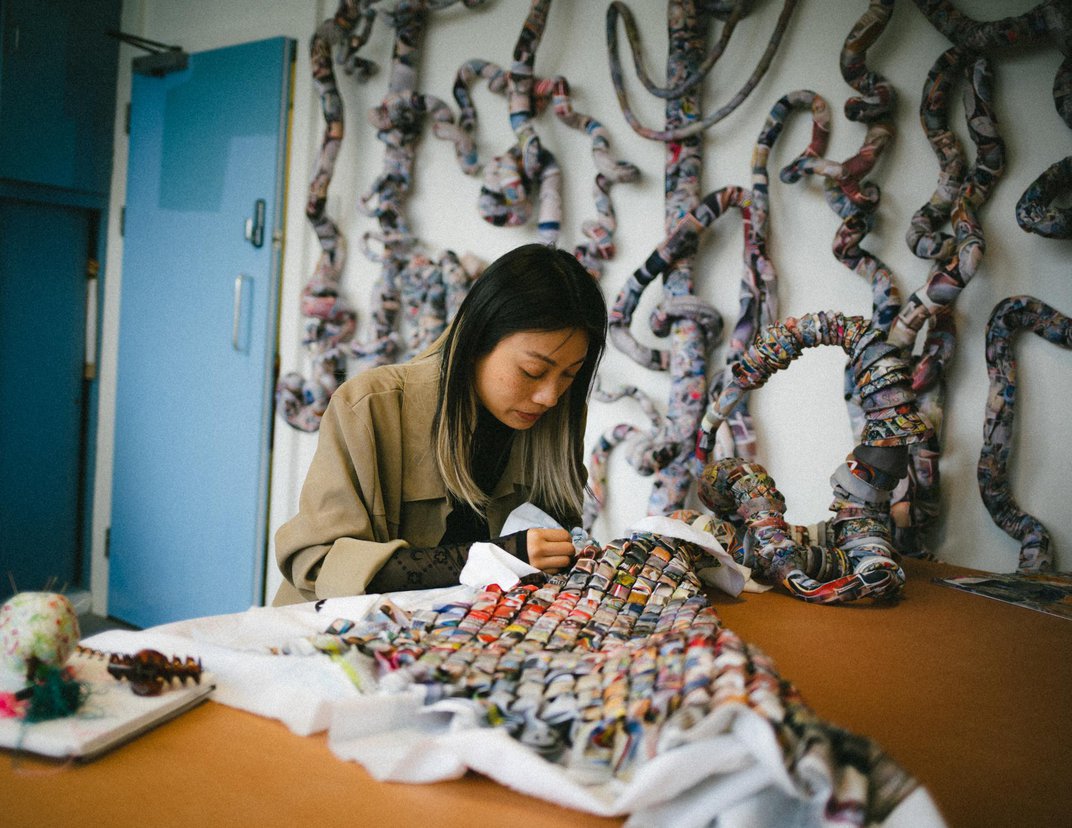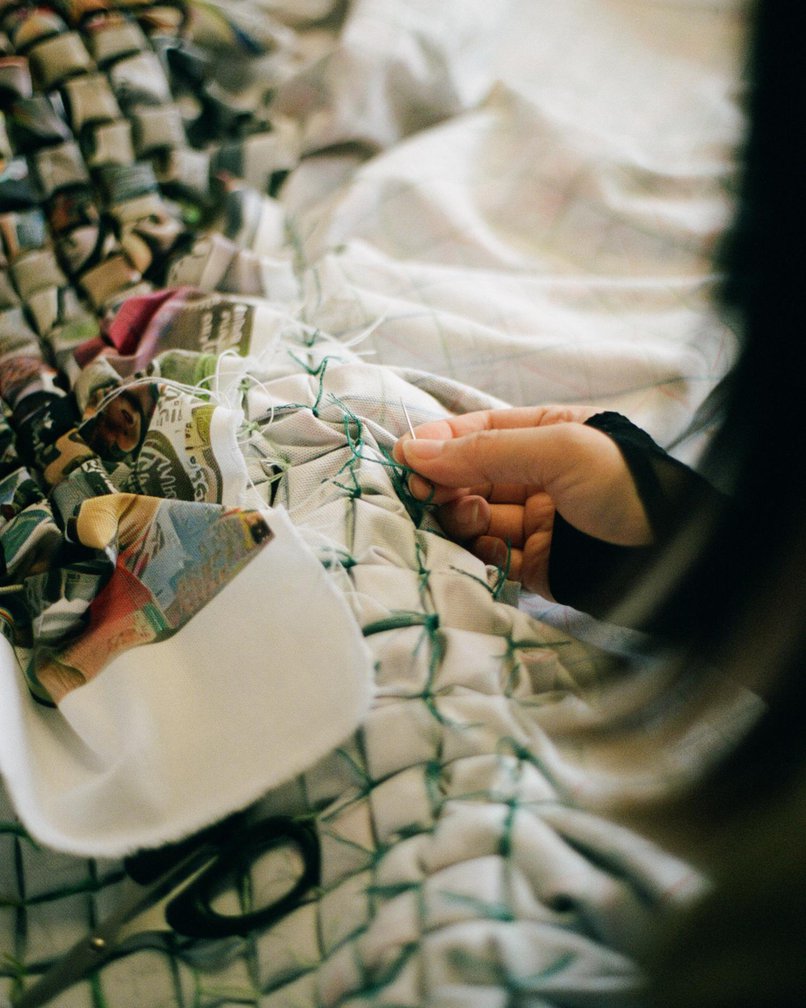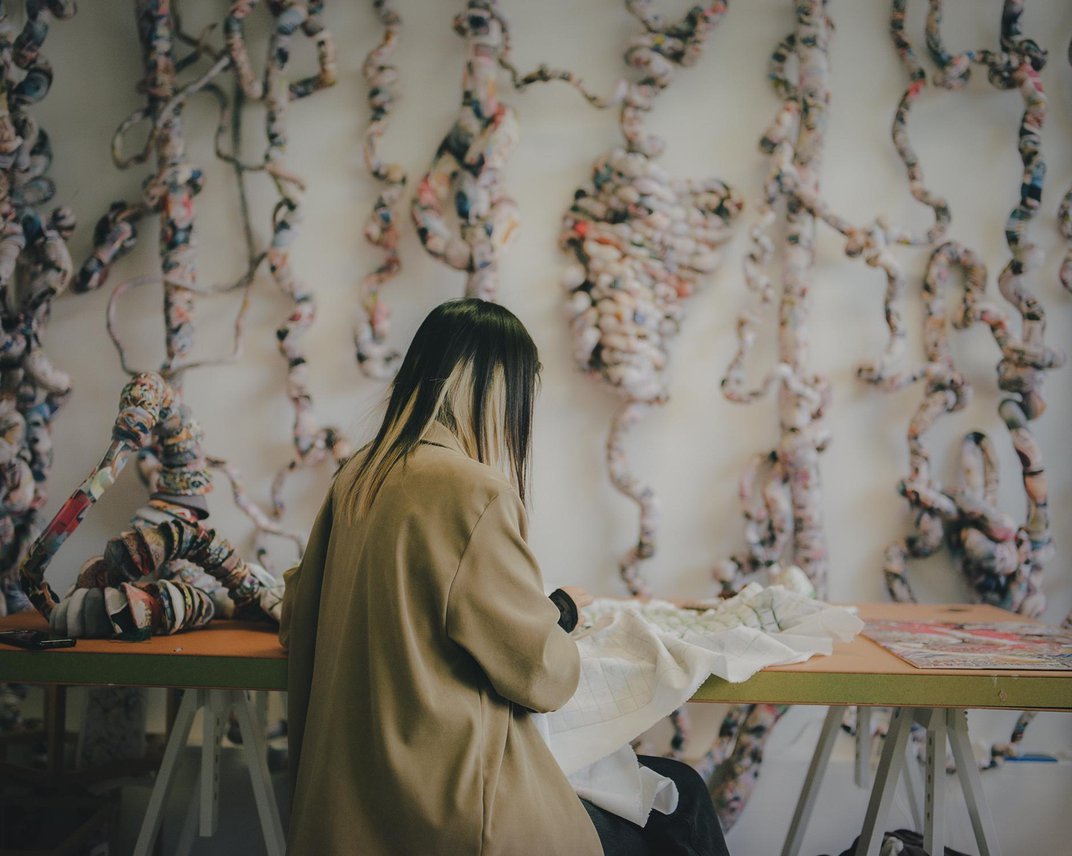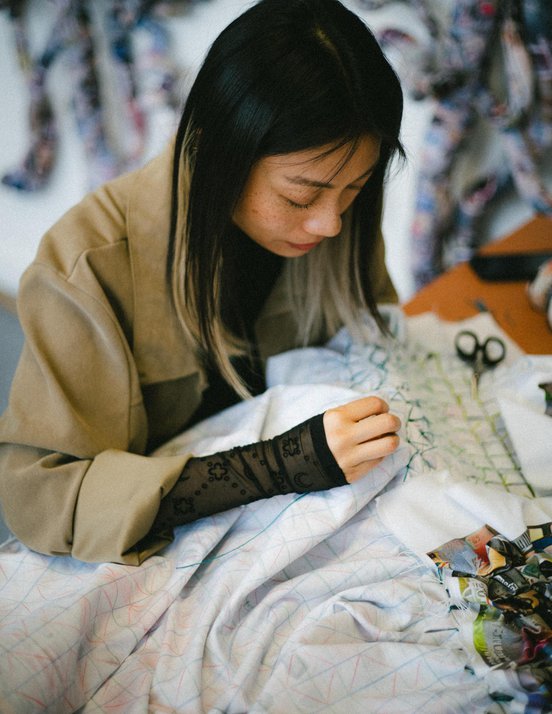article In conversation with
Betty Leung
In conversation with
Betty Leung

In conversation with Betty Leung about the
relationship between technology and migration,
invaluable advice from tutors and learning from
spaces of silence.
relationship between technology and migration,
invaluable advice from tutors and learning from
spaces of silence.
In conversation with Betty Leung about the
relationship between technology and migration,
invaluable advice from tutors and learning from
spaces of silence.
Betty Leung is a London-based Australian multidisciplinary artist of Chinese heritage who combines AI-powered tools, textile work, printmaking and sculpture to explore human behaviours and cultures as well as her personal history.
Twisting and tactile, with endless permutations, each of Betty Leung's pieces embodies fragments of the artist's identity, including the migration experience. Exploring different kinds of tension; between chance and control; between digital and human; between different cultures, Betty's work speaks of a push-pull experience common amongst people who grow up across multiple countries and cultures, trying to navigate the differences and subtleties in customs and sensibilities.
Twisting and tactile, with endless permutations, each of Betty Leung's pieces embodies fragments of the artist's identity, including the migration experience. Exploring different kinds of tension; between chance and control; between digital and human; between different cultures, Betty's work speaks of a push-pull experience common amongst people who grow up across multiple countries and cultures, trying to navigate the differences and subtleties in customs and sensibilities.

Artiq When was the moment you realised you were going to be an artist?
Betty When do we get to call ourselves an artist? What is the criteria to be called an artist? Even though I had been day dreaming of going to art school, I never really dared to think beyond art school. It was only being shortlisted for the 2019 Graduate Art prize that gave me confidence in the work. Winning the prize allowed me to hope that there was a future in this beyond the MA. Even now, I’m acutely aware how precarious a title it is (depending on your definition of an artist) and yet how much privilege I’ve had to be able to pursue this path.
Artiq Who or what has had the most significant influence on your practice?
Betty My practice doesn’t sit neatly within any one context which is reflected in the myriad of influences and sources I draw from - I need a bibliography to share all these! Instead, I’ll talk about Tim Ellis and Jonathan Kearney, both artists and educators. Tim Ellis said to me during my foundation course, sometimes you need to think if the medium you’re using is the most appropriate for your themes/subject, while this is evident across many artists’ work, it was the first time it was made explicitly clear to me. This had a really significant impact because while I was experimenting with different materials, processes etc, at that stage my intention was to paint!
Jonathan Kearney was my MA course leader, he had quite a different approach to tutorials, he never told me what he thought of the work until the very end, instead he asked questions, so he influenced the work in a really subtle and generous way, by getting us to think more deeply and widely. This gave me the space to develop the work, to keep working through it even if I wasn’t sure where it was going.
Betty When do we get to call ourselves an artist? What is the criteria to be called an artist? Even though I had been day dreaming of going to art school, I never really dared to think beyond art school. It was only being shortlisted for the 2019 Graduate Art prize that gave me confidence in the work. Winning the prize allowed me to hope that there was a future in this beyond the MA. Even now, I’m acutely aware how precarious a title it is (depending on your definition of an artist) and yet how much privilege I’ve had to be able to pursue this path.
Artiq Who or what has had the most significant influence on your practice?
Betty My practice doesn’t sit neatly within any one context which is reflected in the myriad of influences and sources I draw from - I need a bibliography to share all these! Instead, I’ll talk about Tim Ellis and Jonathan Kearney, both artists and educators. Tim Ellis said to me during my foundation course, sometimes you need to think if the medium you’re using is the most appropriate for your themes/subject, while this is evident across many artists’ work, it was the first time it was made explicitly clear to me. This had a really significant impact because while I was experimenting with different materials, processes etc, at that stage my intention was to paint!
Jonathan Kearney was my MA course leader, he had quite a different approach to tutorials, he never told me what he thought of the work until the very end, instead he asked questions, so he influenced the work in a really subtle and generous way, by getting us to think more deeply and widely. This gave me the space to develop the work, to keep working through it even if I wasn’t sure where it was going.

Artiq The imagery in your work is created using AI tools. What initially inspired you to work in this way? And what do the artificial hybrid elements convey that a normal image couldn't?
Betty I’m really interested in the relationship between technology, labour and migration. I’m trying to understand the social implications of AI systems and digital technologies - how they might reshape the economy, the future of work and our identities. As part of my practice I experiment with various AI tools - how might decision making delegated to AI amplify existing biases? Concurrently, I’m thinking how do we work with these systems, are they a tool or a collaborator?
The tool I’ve used most extensively is a neural style transfer tool called DeepArt. The tool works by combining the object of the first image with the style of a second image. The research is open source and has been used extensively in various apps.
I was really intrigued by the images it generated when I was feeding it combinations of images that “broke” the figurative objects in the image. I start with two figurative, usually collaged images, that become abstracted, illegible, nonsensical through the process. I was interested in how these original images are there but not there, what fragments of the original you might see and what the viewer might project onto these.
I’m also thinking of the images in terms of translation & language - they can be thought of in the context of Vincenzo Accame’s visual poetry of the 1970s, Glen Ligon’s paintings and the politics of representation in Yinka Shonibare’s work. The very digital or artificial elements, perhaps acts as a timestamp for the work, capturing a particular point in AI development and human computer collaboration.
Artiq Your practice often deals with tensions. For example, the tension between chance and control, between digital and human, and between different cultures. What draws you to work with these kinds of relationships?
Betty I think it comes back to the question, why do we do the things we do? In part I’m trying to understand my own motivations, values, decision making, influences and biases, trying to understand the agency we have. I think the element of push pull is a common experience especially for people who grow up across multiple countries and cultures, trying to navigate the differences and subtleties in customs and sensibilities. Trying to find a balance while you coexist in both.
Betty I’m really interested in the relationship between technology, labour and migration. I’m trying to understand the social implications of AI systems and digital technologies - how they might reshape the economy, the future of work and our identities. As part of my practice I experiment with various AI tools - how might decision making delegated to AI amplify existing biases? Concurrently, I’m thinking how do we work with these systems, are they a tool or a collaborator?
The tool I’ve used most extensively is a neural style transfer tool called DeepArt. The tool works by combining the object of the first image with the style of a second image. The research is open source and has been used extensively in various apps.
I was really intrigued by the images it generated when I was feeding it combinations of images that “broke” the figurative objects in the image. I start with two figurative, usually collaged images, that become abstracted, illegible, nonsensical through the process. I was interested in how these original images are there but not there, what fragments of the original you might see and what the viewer might project onto these.
I’m also thinking of the images in terms of translation & language - they can be thought of in the context of Vincenzo Accame’s visual poetry of the 1970s, Glen Ligon’s paintings and the politics of representation in Yinka Shonibare’s work. The very digital or artificial elements, perhaps acts as a timestamp for the work, capturing a particular point in AI development and human computer collaboration.
Artiq Your practice often deals with tensions. For example, the tension between chance and control, between digital and human, and between different cultures. What draws you to work with these kinds of relationships?
Betty I think it comes back to the question, why do we do the things we do? In part I’m trying to understand my own motivations, values, decision making, influences and biases, trying to understand the agency we have. I think the element of push pull is a common experience especially for people who grow up across multiple countries and cultures, trying to navigate the differences and subtleties in customs and sensibilities. Trying to find a balance while you coexist in both.


Artiq What do you want the audience to take away from your work?
Betty I want the work to be a conversation starter. bell hooks writes in Teaching New Worlds/New Words, 1994 “I suggest that we may learn from spaces of silence as well as spaces of speech that in the patient act of listening to another tongue, we may subvert the culture of capitalist frenzy and consumption that demands or desire must be satisfied immediately. Or we may disrupt that cultural imperialism that suggests one is worthy of being heard only if one speaks in standard English”
Artiq Can you recommend another artist you think everyone should know about?
Betty I really love Sian Fan’s work, she is also a friend and collaborator. Sian is a multidisciplinary artist, her practice blends the physical with the virtual through performance, sculpture, video, VR and AR. Her research explores embodiment, spirituality and human experience in the digital age. She draws on her mixed heritage (Chinese and British) to mediate what it means to exist in between worlds.
Betty I want the work to be a conversation starter. bell hooks writes in Teaching New Worlds/New Words, 1994 “I suggest that we may learn from spaces of silence as well as spaces of speech that in the patient act of listening to another tongue, we may subvert the culture of capitalist frenzy and consumption that demands or desire must be satisfied immediately. Or we may disrupt that cultural imperialism that suggests one is worthy of being heard only if one speaks in standard English”
Artiq Can you recommend another artist you think everyone should know about?
Betty I really love Sian Fan’s work, she is also a friend and collaborator. Sian is a multidisciplinary artist, her practice blends the physical with the virtual through performance, sculpture, video, VR and AR. Her research explores embodiment, spirituality and human experience in the digital age. She draws on her mixed heritage (Chinese and British) to mediate what it means to exist in between worlds.

To learn more about Betty Leung's practice, visit her Website or Instagram.
Betty is currently showing work in the group exhibition London Calling at Unit London, which is open until June 17.
Betty is currently showing work in the group exhibition London Calling at Unit London, which is open until June 17.